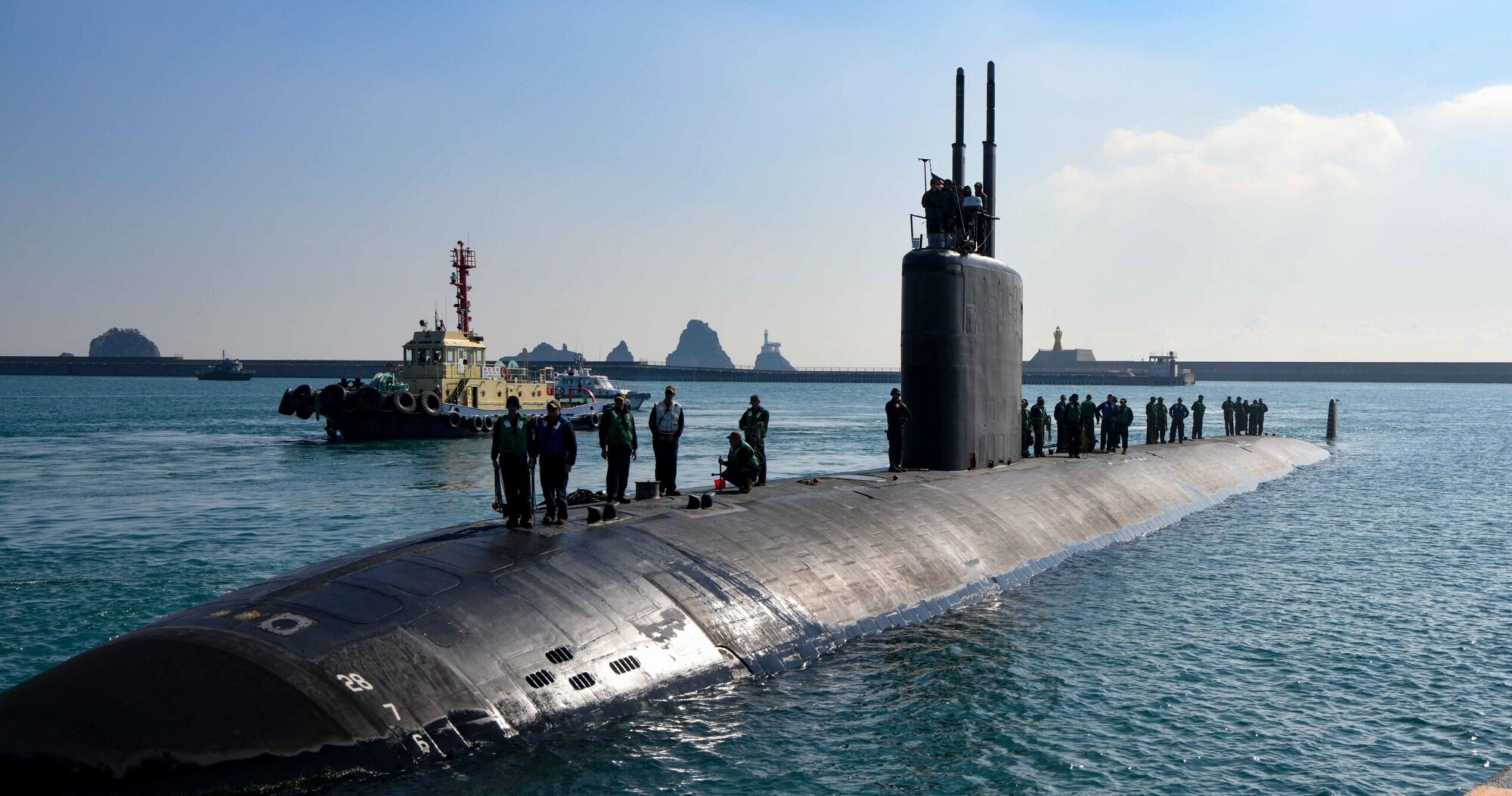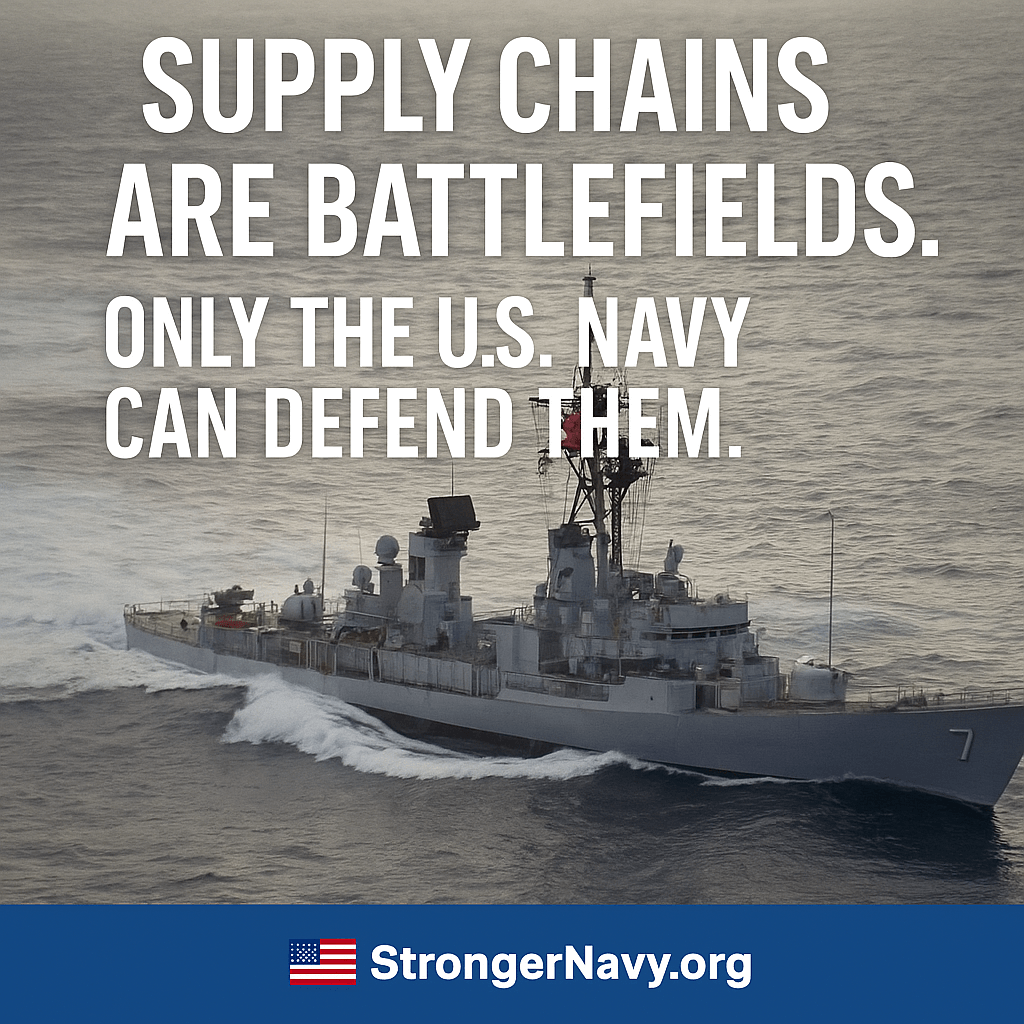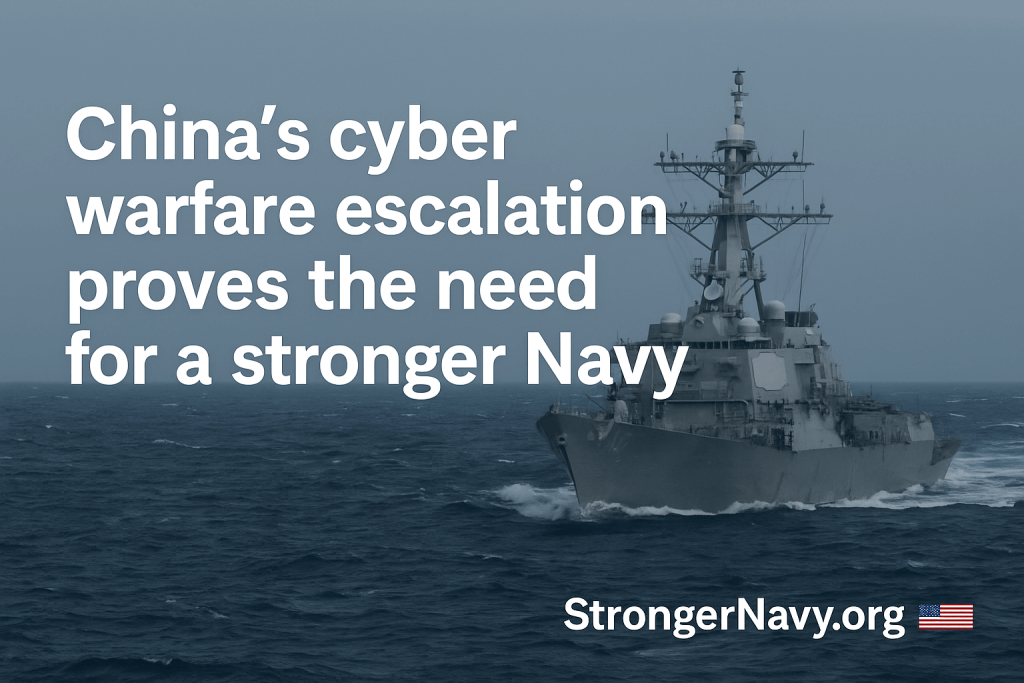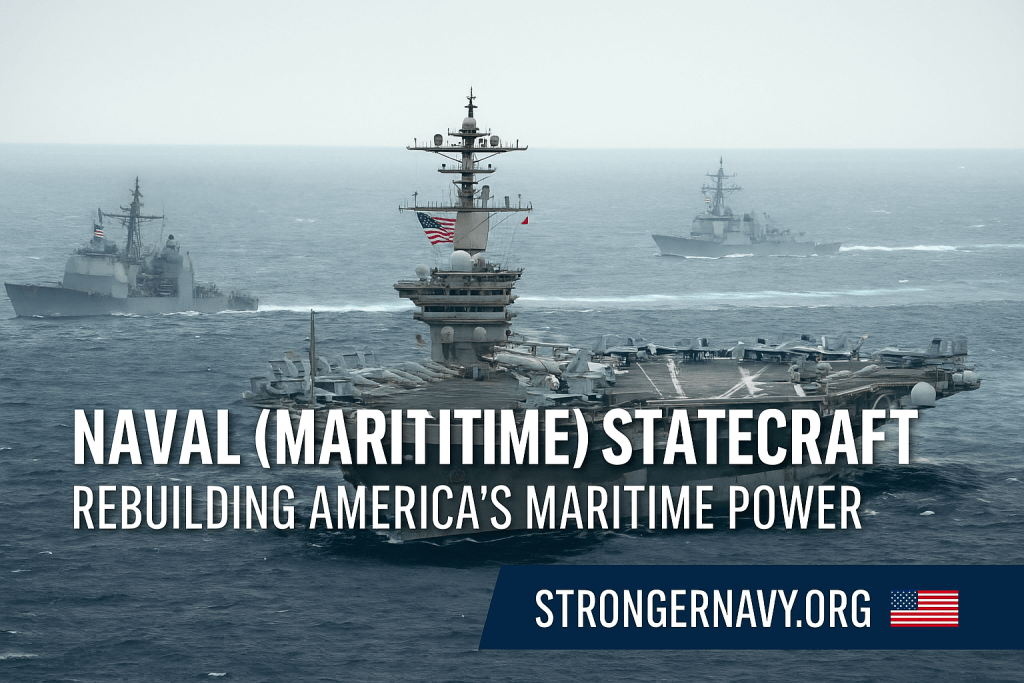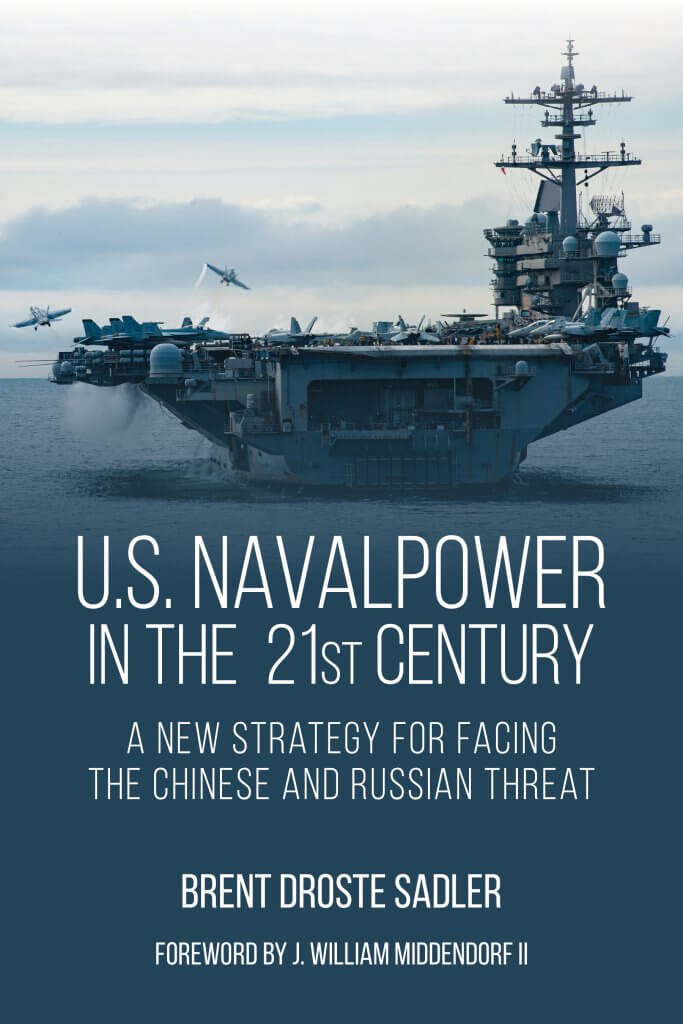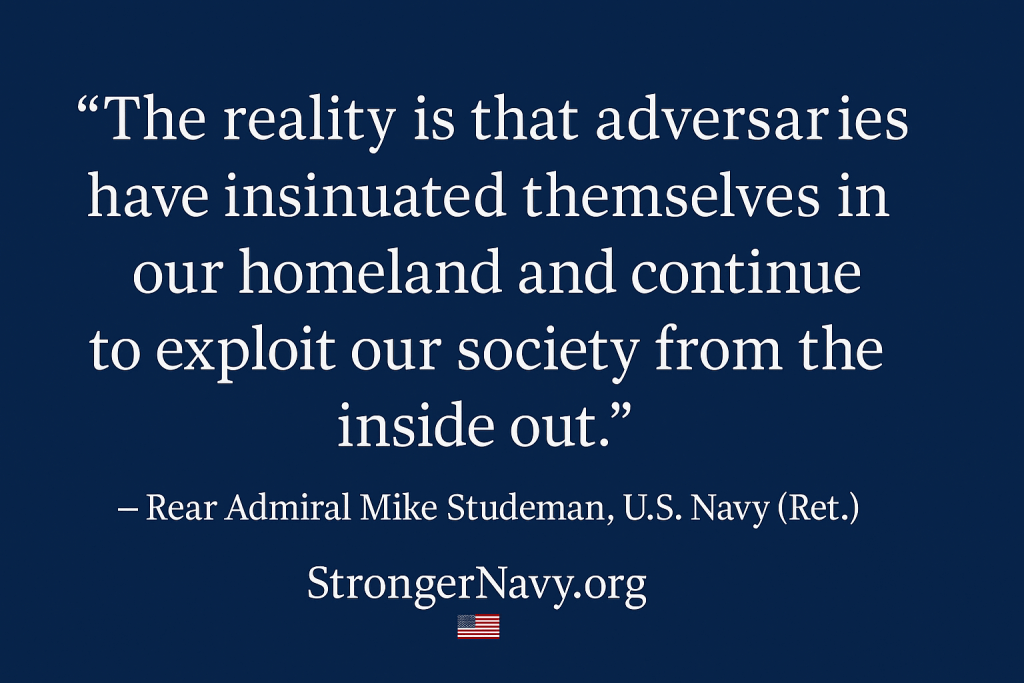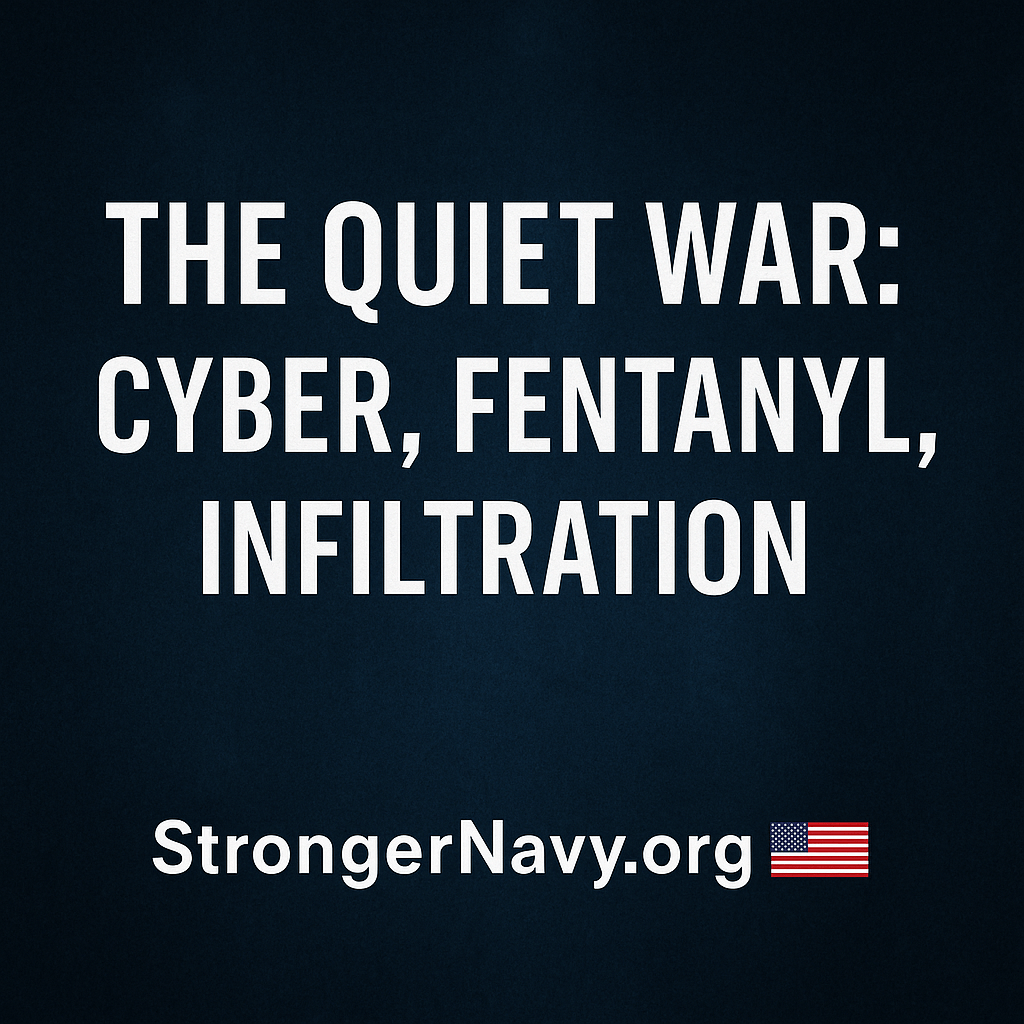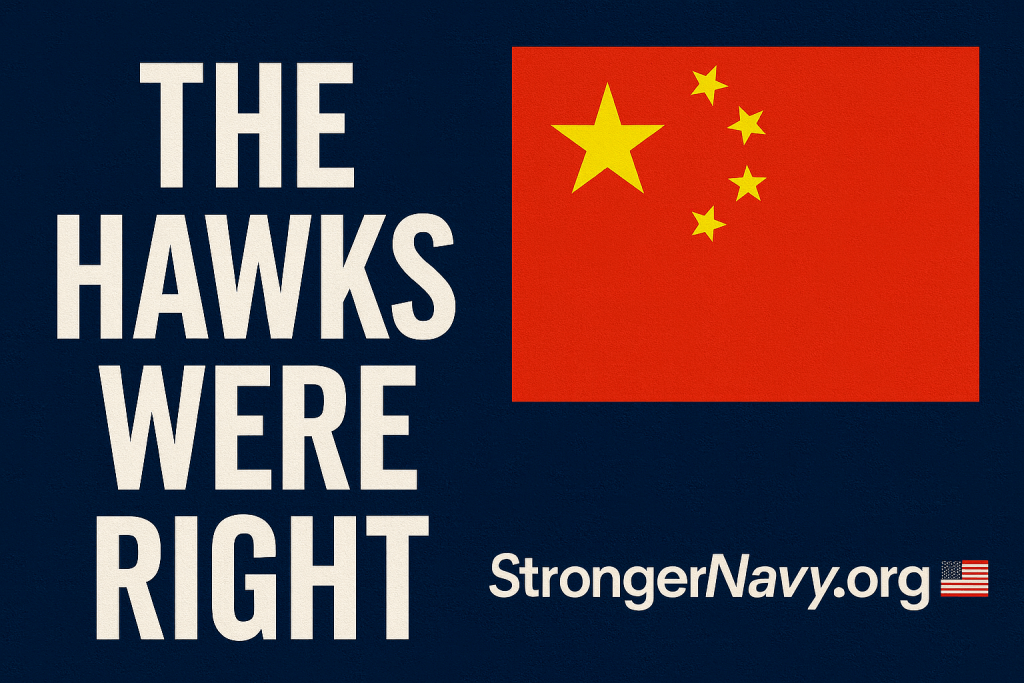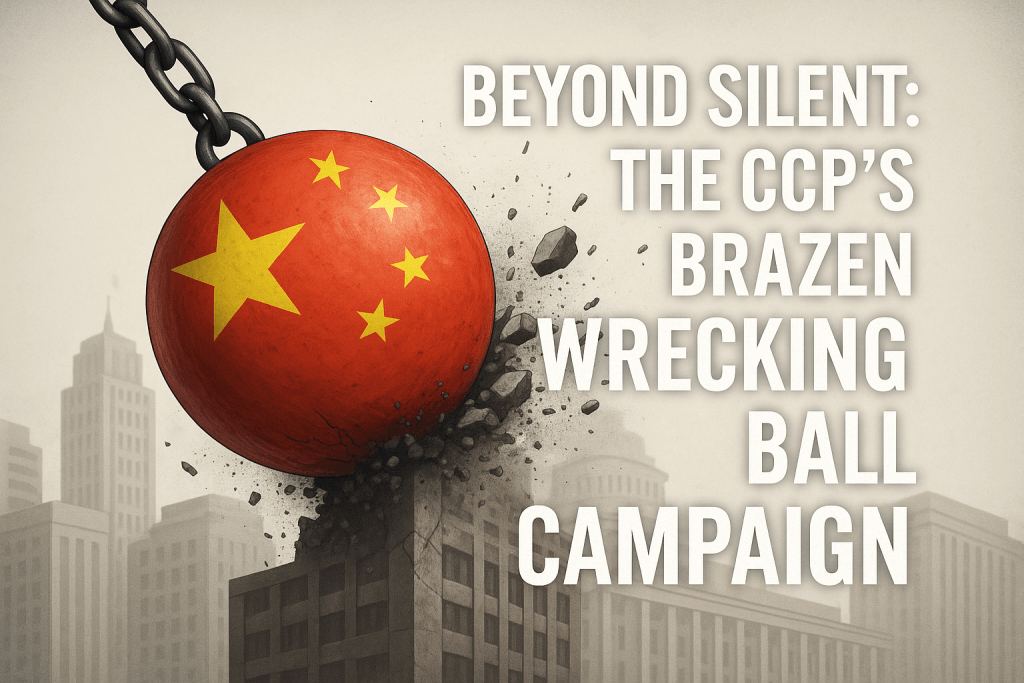A Book Review from Americans for a Stronger Navy

A Note on Staying in Our Lane
Pete Hegseth’s 2024 The War on Warriors has ignited fierce debate across America. As I write this, decorated veterans like Senator Mark Kelly and Pete Hegseth—both men who’ve served with distinction—are in public conflict.
Americans for a Stronger Navy is not going to adjudicate those battles.
What started as an effort to understand Pete Hegseth’s perspective through his book and interviews evolved into something else entirely. As I watched his past interviews and listened to the three-hour conversation with Shawn Ryan, I found myself repeatedly pulled back to our core mission: the urgent need for a Navy capable of deterring China and defending American interests.
While I agree with many of Hegseth’s principles about building a stronger fighting force and improving resources for veterans, I also recognize that his book and interviews reflect a specific moment in time—the period leading up to and following publication. The debates they’ve sparked are important, and good people disagree on the solutions.
But while we debate internally, China doesn’t pause its carrier production.
Our lane is clear: advocating for the naval power necessary to protect America’s future. While others debate military culture, we’re compelled to focus on what both Shawn Ryan and Pete Hegseth spent significant time discussing in their three-hour interview: the existential threat posed by the Chinese Communist Party.
Our veterans deserve better care than they’re receiving. When the VA is failing the warriors who already served, spending defense dollars on elective procedures while vets wait months for basic care is unconscionable. This isn’t a cultural position—it’s a resource management position. Every dollar matters when China is building carriers faster than we can.
With that stated, let’s focus on what should unite all Americans regardless of political persuasion: “China has us by the balls,” says Hegseth. And by our best estimates, we’re running out of time to do something about it.
The Strategic Reality
The most critical parts of the Hegseth-Ryan interview aren’t about DEI or pronouns. They’re about strategic vulnerability to an adversary that’s been playing the long game while we’ve been distracted.
Here’s Pete Hegseth’s unvarnished assessment:
“When they’ve already got us by the balls economically, with our grid, culturally, with elite capture going on around the globe, microchips, everything—why do they want Taiwan? They want to corner the market completely on the technological future. We can’t even drive our cars without the stuff we need out of China these days. They have a full-spectrum, long-term view of not just regional but global domination, and we have our heads up our asses.”
Here’s the short 50 second YouTube clip, watch it for yourself.
Let’s break down what “by the balls” actually means:
Economic Leverage: Our Grid is Their Weapon
China produces all of our electrical transformers, solar panels, and wind turbines. Not most. All. They’re already embedded in our power grid infrastructure. FBI Director Christopher Wray has publicly confirmed Chinese operatives have pre-positioned malware in our electrical grid and water treatment facilities.
As Wray stated, “the dashboard is flashing red and smoking.”
Think about what this means: In the opening hours of a Taiwan conflict, before a single shot is fired at a carrier strike group, China could potentially darken American cities, shut down water systems, and cripple our ability to mobilize.
Our Navy can’t sortie from ports without power. Our sailors can’t fight if their families are in crisis at home.
Naval Asymmetry: We’re Losing the Numbers Game
Hegseth reveals what Pentagon insiders know but rarely admit publicly:
“In the past 10-15 years, the Pentagon has a perfect record in all of its war games against China. We lose every time.”
Every. Single. Time.
Why? Multiple factors:
Numerical Inferiority: China’s Navy now exceeds the U.S. Navy in sheer hull numbers. They’re building aircraft carriers and advanced destroyers at a pace we cannot match with our current industrial base.
Hypersonic Missiles: China has developed hypersonic weapons specifically designed to defeat our carrier strike groups. As Hegseth notes: “If 15 hypersonic missiles can take out our 10 aircraft carriers in the first 20 minutes of a conflict, what does that look like?”
Our primary tool of power projection—the carrier strike group—may be obsolete on Day One of a Pacific conflict.
Supply Chain Dependency: When Shawn Ryan mentions defensive technologies like directed EMP weapons (from companies like Epirus) that can counter drone swarms, even he expresses concern: “I don’t know if anything’s coming from China. I don’t know what other weapons we have and what’s manufactured in China or what IP they’ve stolen from us.”
We can’t even be certain our most advanced defensive systems aren’t compromised by Chinese components or stolen intellectual property.
The Microchip Chokepoint: Taiwan is Everything
Why does China want Taiwan? Not reunification nostalgia. Taiwan is the beating heart of the global economy and modern civilization.
Taiwan Semiconductor Manufacturing Company (TSMC) doesn’t just produce “the majority” of advanced microchips—it produces over 90% of the world’s most advanced semiconductors. These aren’t chips for smartphones and laptops. These are the chips that power:
- Every advanced weapon system – F-35s, guided missiles, radar systems, naval combat systems
- Every AI system – From civilian applications to military command and control
- Every modern vehicle – Cars, trucks, tractors, commercial aircraft
- Every hospital – MRI machines, CT scanners, surgical robots, monitoring equipment
- Every communications system – Cell towers, satellites, internet infrastructure
- Every financial system – Banking, stock markets, payment processing
If China controls Taiwan, China controls the technological backbone of human civilization.
This isn’t hyperbole. During the COVID chip shortage, automobile production halted worldwide. Factories sat idle. Dealership lots emptied. That was a supply chain hiccup. Imagine China with a monopoly, deciding who gets chips and who doesn’t.
American weapon systems would depend on Chinese approval for components. American hospitals would need Chinese permission to operate. American banks would require Chinese consent to process transactions.
This is why Taiwan isn’t just another regional territorial dispute. Taiwan is the strategic fulcrum upon which the entire 21st century will turn.
And China knows it. That’s why they’re building a military specifically designed to take Taiwan before we can effectively respond. That’s why every hypersonic missile, every carrier, every amphibious assault ship they build is calculated toward this single objective.
Salt Typhoon: They’re Already Inside
In late 2024, U.S. intelligence agencies revealed that Chinese hackers operating under the codename “Salt Typhoon” had achieved deep, persistent access to American telecommunications infrastructure.
Not a probe. Not a test. Deep, persistent access.
They’re inside AT&T, Verizon, T-Mobile networks. They can intercept phone calls, text messages, internet traffic. They’ve targeted senior government officials, military personnel, critical infrastructure operators.
This isn’t theoretical preparation for future conflict. This is active intelligence collection happening right now.
Combined with their penetration of our electrical grid (FBI Director Wray’s “flashing red dashboard”), their control over our transformer supply chains, their dominance in 5G infrastructure, and their positioning in our water treatment systems—China has achieved the infiltration necessary to paralyze America without firing a shot.
When the Taiwan crisis comes—and it will come—our response will be shaped by what China has already positioned to cripple us from within.
The Indo-Pacific: Where Our Future Will Be Decided
The Indo-Pacific region isn’t one theater among many. It’s THE theater where American prosperity and security will be won or lost.
Consider the stakes:
Economic: Over 60% of global maritime trade flows through the South China Sea. $3.4 trillion in trade passes through the Taiwan Strait annually. If China controls these waters, they control global commerce.
Alliance Structure: Japan, South Korea, the Philippines, Australia, India—our entire network of Pacific allies depends on American commitment. If we cannot or will not defend Taiwan, why would anyone trust American security guarantees?
Resources: Critical minerals, rare earth elements, advanced manufacturing—the Indo-Pacific is the industrial and technological center of the 21st century. Ceding this region to Chinese dominance means accepting permanent economic subservience.
Naval Power Projection: If China controls the First Island Chain (Japan-Taiwan-Philippines), American naval power is effectively contained to Pearl Harbor and San Diego. Our ability to operate globally collapses.
This isn’t about the military-industrial complex wanting another war. This is about the economic and security future of our children and grandchildren.
This is Nothing Like Vietnam, Iraq, or Afghanistan
I understand the skepticism. Both Pete Hegseth and Shawn Ryan expressed it in their interview—they’re both “recovering neocons” who supported Iraq and Afghanistan and now recognize those were strategic disasters.
Vietnam, Iraq, and Afghanistan were wars of choice built on questionable premises:
- Nation-building missions in societies we didn’t understand
- No vital national interests at stake
- No clear victory conditions
- Counterinsurgency in impossible terrain against irregular forces
- Decades-long occupations with no end state
- Trillions spent with nothing to show for it
The potential Taiwan conflict is fundamentally different:
1. Vital National Interests: Taiwan semiconductors aren’t optional. Modern civilization depends on them. This isn’t about abstract concepts like “democracy promotion”—it’s about maintaining access to the technology that runs everything from hospitals to power grids.
2. Deterrence, Not Occupation: We don’t need to occupy Chinese territory or rebuild their society. We need to make the cost of taking Taiwan prohibitively high. That’s classic deterrence, not nation-building.
3. Conventional Warfare: This would be state-on-state naval and air conflict where American technological advantages matter, not counterinsurgency in urban terrain where they don’t.
4. Clear Objectives: Maintain Taiwan’s de facto independence and semiconductor production. That’s it. No “hearts and minds,” no transforming societies, no endless occupation.
5. Alliance Structure: We’d fight alongside Japan, Australia, potentially South Korea and others with shared interests. This isn’t America alone trying to remake a foreign society.
6. Existential Stakes: If China controls Taiwan’s chips, they control the global economy. If they demonstrate American security guarantees are worthless, our entire alliance system collapses. If they dominate the Indo-Pacific, American prosperity ends.
The lesson from Vietnam, Iraq, and Afghanistan isn’t “never fight wars.” It’s “don’t fight stupid wars based on lies about stupid objectives in stupid ways.”
Deterring China from taking Taiwan is none of those things. It’s the most strategically vital mission American naval power faces.
This is about ensuring our grandchildren grow up in a free, prosperous America—not one subordinated to Chinese Communist Party dictates because we couldn’t muster the will to maintain our position when it mattered most.
Economic Warfare: The Crypto Scam Example
Hegseth and Ryan discuss an underreported aspect of Chinese strategic operations: systematic economic extraction through crypto scams.
Chinese operatives run sophisticated confidence schemes:
- Approach target with small crypto investment opportunity ($15,000)
- Deliver real returns quickly ($45,000) to build trust
- Escalate to larger investments ($200,000)
- When target invests life savings ($1,000,000+), disappear with everything
This isn’t individual crime—it’s organized economic warfare to extract American wealth before potential conflict.
Ryan’s local sheriff’s department just tracked one operator across multiple states to Las Vegas. “It’s happening all over the place,” Ryan notes.
Cultural Infiltration: TikTok and Beyond
As Hegseth observes: “We let in TikTok where they can trans our kids and they don’t trans their kids.”
Whether you agree with his framing or not, the strategic point is valid: China operates TikTok to influence American youth while banning it domestically. That’s not cultural exchange—that’s information warfare.
The CCP understands something we’ve forgotten: The side that controls what the next generation believes controls the future.
The Long Game: China’s Strategic Patience
Here’s what separates China’s approach from ours:
China’s Strategy:
- Multi-decade planning horizon
- Systematic IP theft and technology acquisition
- Economic positioning for future conflict
- Military buildup specifically designed to defeat the United States
- Cultural and political elite capture
- Infrastructure positioning (ports, 5G networks, supply chains)
America’s Strategy:
- 2-4 year election cycles driving policy
- Letting China manufacture our critical infrastructure
- Outsourcing our industrial base for quarterly profit margins
- Assuming the international rules-based order will protect us
- Internal political warfare consuming our attention
As Hegseth puts it: “China is playing chess while we’re arguing about pronouns.”
The Timing Question: When Will They Strike?
Both Ryan and Hegseth wrestle with a critical strategic question: When will China make its move on Taiwan?
Ryan’s analysis is chilling:
“If I was them, I would put in the scenario into war games and see what the probability is that we’re going to come out on top. I wouldn’t make a move until after this election because they know what’s going on. They see it. Nobody made any weird moves under Trump that I’m aware of. As soon as they got in—Russia went after Ukraine, tensions with Taiwan getting stronger, the border, Israel—everybody that wanted to make a chess move on the board did it as soon as Trump was out of office.”
“If I was them, I would make my move the first day that Trump is in office because that would be the weakest point before we start to see an incline. And if Kamala gets in there, I would wait another four years, just let it keep declining, and that would just let this place get as weak as it possibly can, and then I would pull the trigger.”
Think about that logic:
- China runs the scenarios through their war game simulations
- They update the probability matrices with current data
- Every year we decline, their probability of victory increases
- They wait until the optimal moment
The clock is ticking. And we’re not on it.
What This Means for the Navy
Everything Hegseth discusses in the Army context applies with even greater urgency to naval forces:
Recruitment Crisis: The Navy can’t crew the ships we have, let alone the fleet we need. If patriotic families from military traditions are second-guessing service, where do future sailors come from?
Retention Problems: Experienced petty officers and junior officers are leaving. Institutional knowledge walks out the door with them.
Technical Expertise Gap: Modern naval warfare requires STEM-educated personnel. Our education system is producing activists, not engineers.
Readiness vs. Rhetoric: Hegseth mentions sailors in the DMZ in Korea reporting they have “basically enough artillery for 3 days—the rest of it’s in Ukraine.” How many naval munitions have been drawn down? How many maintenance dollars diverted?
Close Quarters Reality: Destroyers, cruisers, submarines—these platforms require maximum unit cohesion in confined spaces over extended deployments. Any policy that complicates that dynamic affects operational capability.
Industrial Base Collapse: We can’t build ships fast enough. China launches a new carrier while we’re still arguing about shipyard contracts.
Why the Navy? Why Not Just “Military” Generally?
Americans for a Stronger Navy focuses specifically on naval power for a fundamental reason: The China challenge is inherently a maritime problem.
Consider the geography:
70% of Earth’s surface is water. The Indo-Pacific theater is defined by vast ocean expanses, island chains, and sea lanes. This isn’t the deserts of Iraq or the mountains of Afghanistan—it’s a maritime domain where naval power is decisive.
Taiwan is an island 100 miles from mainland China. Any conflict over Taiwan is fundamentally an amphibious assault/defense scenario. China must cross water. We must defend across water. The Air Force matters, the Army matters, but the Navy is the primary deterrent.
The First Island Chain is maritime. Japan, Okinawa, Taiwan, the Philippines, Indonesia—the strategic barrier that contains Chinese power projection is a series of islands. Controlling this chain means controlling maritime access. Losing it means Chinese naval dominance from the South China Sea to the Pacific.
Global trade flows through water. Over 90% of global trade moves by ship. The South China Sea handles $3.4 trillion annually through the Taiwan Strait alone. If China controls these sea lanes, they control global commerce. You can’t secure maritime trade with land forces.
Distance matters. The nearest U.S. territory to China is Guam—3,000 miles from California. You can’t project power across the Pacific with the Army. The Navy is how America reaches the theater. The Navy is how we sustain operations. The Navy is how we defend allies. Without naval dominance, we’re not even in the game.
China understands this. That’s why they’re building the world’s largest navy. Not the world’s largest army (they already had that). They’re specifically building carriers, destroyers, submarines, amphibious assault ships—naval power to challenge American naval power.
They’ve studied American carrier strike groups and designed hypersonic missiles to sink them. They’ve built artificial islands in the South China Sea to extend their naval reach. They’re developing a blue-water navy capable of operating globally.
The Indo-Pacific challenge is a naval challenge. China’s threat is a naval threat. Our response must be naval.
That’s why Americans for a Stronger Navy exists. We’re not generically “pro-military.” We’re specifically focused on the domain where the 21st century’s decisive competition will be won or lost: the sea.
The Resource Allocation Question
Here’s where Americans for a Stronger Navy takes a clear position:
Military resources must be allocated to maximize readiness and deterrence. Period.
That means:
This isn’t about culture. It’s about math.
If we’re losing every war game against China, if our carriers are vulnerable to hypersonic missiles, if our grid can be darkened remotely, if Taiwan is the strategic prize of the century—then every resource decision matters.
The Education Pipeline: Tomorrow’s Sailors
Hegseth spends significant time in both the book and interview discussing education, and this directly impacts naval readiness.
The Navy needs:
- Nuclear-trained operators for submarines and carriers
- Electronics technicians for advanced systems
- Engineers for damage control and propulsion
- Cryptologists and cyber warriors
- Aviators with complex technical training
This requires:
- Strong STEM education
- Rigorous academic standards
- Technical aptitude
- Problem-solving capability
- Discipline and work ethic
What’s happening in K-12 education:
- Math and science proficiency declining
- Reading scores dropping
- Grade inflation masking actual competency
- Social-emotional learning replacing academic rigor
- Anti-American narratives that discourage service
The pipeline is broken. Even if we solve every other problem, we can’t crew a technically complex fleet with graduates who can’t do algebra.
This is where Hegseth’s education critique directly intersects with naval readiness. China is graduating millions of STEM students. We’re graduating activists who think America is irredeemably evil. Who’s going to win that competition?
What We Learned From a Destroyer Sailor
I served on a U.S. Navy destroyer in the 1970s. Several shipmates reached out over the past few years expressing concerns about changes in today’s Navy. I’ll admit I was initially skeptical—were they exaggerating? Were they just resistant to change?
After reading Hegseth’s book and listening to the three-hour Ryan interview, I realize I should have listened more carefully to the warnings. But I also realize something else:
We’re spending so much energy fighting each other that we’re not focusing on the actual threat.
My shipmates on both sides of these cultural debates all agree on one thing: China is the threat. They disagree on solutions to internal problems, but they all recognize the external danger.
That’s where Americans for a Stronger Navy needs to focus.
Let the cultural debates happen. Let good people like Senator Kelly and Pete Hegseth have their disagreements. Our job is to relentlessly advocate for:
- Sufficient naval hulls to match China’s growing fleet
- Advanced weapon systems that counter hypersonic threats
- Industrial base that can actually build ships at competitive speed
- Recruitment and retention of qualified personnel
- Training and readiness focused on war-fighting
- Supply chain independence from Chinese manufacturing
- Electrical grid hardening so our bases can operate
- Cybersecurity that prevents Chinese infrastructure penetration
- Educational reform that produces STEM-capable recruits
- Budget prioritization toward capabilities over social experiments
The Three-Hour Wake-Up CalIf the warnings from Ryan and Hegseth about the CCP don’t shake you to the core, I don’t know what will.
Here’s what should terrify every American:
- Pentagon loses every war game against China
- China’s Navy now exceeds ours in numbers
- Hypersonic missiles can sink our carriers in minutes
- Chinese malware already embedded in our grid
- Taiwan’s semiconductor monopoly is China’s target
- Economic warfare extracting American wealth daily
- Our sailors report ammunition shortages
- Recruiting and retention in crisis
- Industrial base can’t build ships competitively
- Education system failing to produce technical talent
And while all this is happening, Americans are fighting each other instead of the actual enemy.
Our Call to Action
Americans for a Stronger Navy has a clear mission: advocating for the naval power necessary to defend America and deter aggression.
After reviewing Hegseth’s book and the extended Ryan interview, here’s what we’re calling for:
Immediate Priorities:
1. China Threat Education We will dedicate equal or greater time to educating Americans about the CCP threat as we spend on internal debates. The Ryan-Hegseth interview should be required viewing for anyone concerned about national security.
2. Resource Allocation Focus Every dollar matters when you’re losing war games. We support policies that maximize readiness and deterrence, including ending taxpayer funding for elective medical procedures that render service members non-deployable.
3. Industrial Base Revival We cannot have a strong Navy without shipyards that can build ships. This requires industrial policy, workforce development, and political will.
4. Grid Hardening Naval bases can’t operate without power. American families can’t support deployed sailors if they’re in crisis at home. Chinese control of our infrastructure must end.
5. Supply Chain Independence We must stop buying critical military components from our primary adversary. Yes, it will be expensive. No, we don’t have a choice.
6. Education Pipeline Repair Supporting classical education, STEM focus, and programs that produce technically capable recruits is a national security imperative.
7. Bipartisan Unity on China This is the one thing that should unite Americans across political divides. China is not Republican or Democrat. They’re our adversary, and they’re winning.
What You Can Do:
1. Watch the Full Interview The three-hour Shawn Ryan Show interview with Pete Hegseth contains more strategic analysis than most national security briefings. Share it widely.
2. Contact Your Representatives Demand they prioritize naval shipbuilding, infrastructure hardening, and China competition over internal political warfare.
3. Support STEM Education Whether through donations, volunteering, or advocacy—we need the next generation capable of operating advanced naval systems.
4. Spread Awareness Most Americans have no idea how vulnerable we are or how aggressively China is positioning for dominance. Change that.
5. Stay Focused on the Mission Don’t let internal debates distract from external threats. We can disagree on culture while agreeing on China.
Conclusion: The Enemy Gets a Vote—But So Do We
There’s a military axiom: “The enemy gets a vote.”
While America argues about pronouns, DEI, and cultural issues, China is voting with carrier launches, hypersonic missile tests, infrastructure infiltration, and economic positioning.
While good Americans like Senator Kelly and Pete Hegseth have their necessary debates about military culture, China is running war game simulations and updating their probability matrices for success.
While we fight over what makes someone qualified for military service, China is building the fleet that will challenge our ability to defend Taiwan, Japan, Korea, and the Philippines.
The clock is ticking.
But here’s what the alarm shouldn’t become: despair.
What started as a book review to understand Pete Hegseth’s perspective became a stark reminder of what actually matters: our children’s future. And that future is not predetermined. China’s rise is not inevitable. American decline is a choice, not a destiny.
We Have Advantages China Can’t Match
American Innovation: When we freed American energy production, we became energy independent within years. When COVID hit, we developed multiple vaccines in record time. When we commit to solving problems, we still lead the world in innovation.
Emerging Technologies: Directed energy weapons, autonomous systems, AI-enabled targeting, hypersonic defense systems—American companies are developing technologies that can offset Chinese numerical advantages. The Epirus directed EMP system Ryan and Hegseth discussed is just one example.
Alliance Structure: China stands largely alone. We have Japan, South Korea, Australia, the Philippines, and emerging partnerships with India and others. China has no equivalent alliance structure. Authoritarian systems inspire fear, not loyalty.
Economic Strength: Despite our challenges, the U.S. economy remains the most dynamic, innovative, and resilient in the world. Our capital markets, universities (when focused on STEM), and entrepreneurial culture are unmatched.
Geographic Position: China must project power across oceans to threaten American territory. We’re protected by two vast moans and friendly neighbors. They have hostile or unreliable neighbors on every border.
The WWII Precedent: In 1940, America had the 17th largest military in the world. By 1945, we had built the arsenal of democracy and defeated two major powers simultaneously on opposite sides of the globe. When America gets serious, we can mobilize faster than any nation on Earth.
This is Winnable—If We Act Now
The Pentagon may lose every war game against China today, but war games assume current capabilities. We can change those capabilities.
We can build more ships. We built 175 ships in two years during WWII. We can revitalize our shipyards.
We can harden our infrastructure. We built the Interstate Highway System, the Hoover Dam, put men on the moon. We can protect our power grid.
We can secure our supply chains. We can reshore critical manufacturing. We can incentivize chip fabrication in America.
We can fix our education system. Classical education is growing. Homeschooling is expanding. STEM-focused alternatives exist.
We can restore deterrence. China only moves on Taiwan if they believe they’ll win. Make the cost prohibitive, and they won’t move.
This requires political will, not miracles. It requires Americans to stop fighting each other and focus on the actual adversary. It requires leaders who prioritize national security over political advantage. It requires citizens who demand action.
And it requires a Navy capable of controlling the seas.
Pete Hegseth’s The War on Warriors contains valuable warnings about institutional problems. The debates his book has sparked are important, and good people disagree on solutions. But the most critical warning in both the book and the Ryan interview isn’t about wokeness—it’s about China.
“They have a full-spectrum, long-term view of not just regional but global domination, and we have our heads up our asses.”
I understand the weariness from Vietnam, Iraq, and Afghanistan. Both Hegseth and Ryan express it—they’re “recovering neocons” who supported wars they now recognize as mistakes. But the Taiwan situation isn’t another optional nation-building adventure. It’s about the semiconductor supply that powers modern civilization, the alliance structure that maintains global stability, and the economic future our grandchildren will inherit.
This isn’t about the military-industrial complex wanting another war. This is about whether America remains a free, sovereign nation or becomes economically subordinated to Chinese Communist Party control.
Americans for a Stronger Navy exists because we understand that naval power is not optional in a maritime century against a maritime threat. We exist because someone needs to focus relentlessly on building the fleet, supporting the sailors, and educating Americans about what’s at stake.
We need a stronger Navy. We need it now. We need the tools, resources, training, personnel, and industrial base to match the threat.
Our veterans who already served deserve the care they earned—not to see their VA benefits delayed while billions go elsewhere.
Our sailors need ammunition, not just for three days, but for sustained operations.
Our children need semiconductor access that doesn’t depend on Chinese permission.
Our grandchildren deserve to grow up in a free America, not one bowing to Beijing because we couldn’t maintain our naval power when it mattered most.
But they also deserve to grow up knowing their parents and grandparents didn’t give up. That when faced with a determined adversary, America remembered who we are and what we’re capable of achieving.
Everything else is secondary to this mission.
Let’s stop fighting each other and start focusing on the actual enemy. Let’s stop despairing and start building. Let’s stop the internal warfare and restore the external deterrence.
The Salt Typhoon hackers are already inside our telecommunications systems. Chinese malware is pre-positioned in our electrical grid. China controls our transformer supply. They’re building carriers while we argue about culture. They’re war-gaming Taiwan scenarios while we debate pronouns.
But we can still win this. We have time—barely—to restore deterrence, rebuild capacity, and secure our position.
The question isn’t whether we can. It’s whether we will.
Americans for a Stronger Navy is committed to this fight. We’ll continue advocating for the naval power our nation needs. We’ll continue educating Americans about the China threat. We’ll continue supporting the sailors who keep us safe.
Join us. The future our grandchildren inherit depends on what we do right now.
Note: In future posts, we’ll address specific topics including:
- Detailed naval force structure requirements and shipbuilding timelines
- The shipyard and industrial base crisis—and how to solve it
- Allied burden-sharing and the AUKUS partnership
- Economic warfare beyond military competition (ports, Belt and Road, fentanyl, elite capture)
- How to pay for naval expansion and why we can’t afford not to
- Concrete legislative actions and how to engage your representatives effectively
Stay focused on the mission. The Navy we need is within reach if we have the will to build it.
About Americans for a Stronger Navy
Americans for a Stronger Navy is dedicated to promoting peace through strength by supporting a robust, modern, and capable United States Navy. We advocate for the resources, policies, and personnel necessary to ensure American naval dominance and the security of our maritime interests.
Our mission is focused, non-partisan, and urgent: Build the Navy we need to deter the China threat.
This review reflects the analysis of one destroyer sailor who served in the 1970s and believes Americans on all sides of cultural debates can unite around the China threat. We encourage readers to form their own opinions on internal military debates while maintaining absolute clarity on external threats.
The War on Warriors: Behind the Betrayal of the Men Who Keep Us Free
By Pete Hegseth
Published 2024
Recommended for: Anyone concerned about national security, China competition, and America’s strategic position
Key Takeaway: Stop fighting each other. Start focusing on China.
Rating: ★★★★ (Important Strategic Warning)
